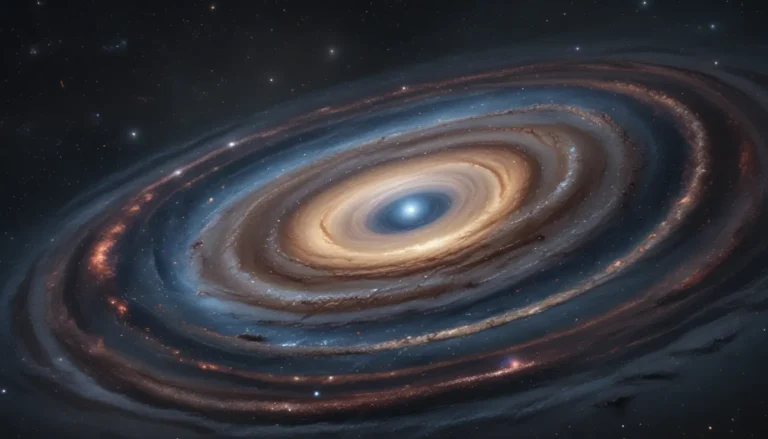The pictures we use in our articles might not show exactly what the words say. We choose these pictures to make you interested in reading more. The pictures work together with the words but don’t take their place. The words still tell you the important facts.
The vast expanse of space holds within it some of the most captivating and enigmatic phenomena that continue to intrigue scientists and astronomers alike. One such field of study that delves into the most extreme and energetic events in the cosmos is spaceborne gamma-ray astronomy. This unique branch of astronomy focuses on the observation and analysis of high-energy gamma rays emitted by celestial objects, shedding light on the most violent processes occurring across the universe.
In this article, we will embark on a journey through the enthralling world of gamma-ray astronomy, exploring 20 fascinating facts that will provide valuable insights into the universe's most energetic events. From the inception of gamma-ray telescopes to groundbreaking discoveries made by space missions, we will unravel the mysteries that lie beyond our planet and broaden our understanding of the cosmic landscape.
Peering into the Abyss: The World of Gamma-ray Astronomy
- Gamma rays unveil the universe's energetic events: With the highest frequency in the electromagnetic spectrum, gamma rays offer a unique window into the most powerful events in the cosmos, including supernovae explosions and supermassive black hole flares.
- Gamma-ray telescopes reveal hidden cosmic phenomena: By detecting gamma rays from space, these telescopes enable scientists to uncover elusive processes such as antimatter collisions and the acceleration of high-energy particles, unlocking the universe's secrets one gamma ray at a time.
- The Explorer 11 inaugurates spaceborne gamma-ray astronomy: Launched in 1961 by NASA, the Explorer 11 satellite carried the first instrument capable of detecting gamma rays from space, heralding a new era in the field of gamma-ray astronomy.
Exploring the Cosmic Marvels Through Gamma-ray Astronomy
- Fermi Gamma-ray Space Telescope: Launched in 2008 by NASA, the Fermi telescope is dedicated to observing gamma rays, significantly advancing our understanding of high-energy astrophysics.
- Pulsars: The powerhouse of gamma rays: Pulsars, rapidly rotating neutron stars, emerge as the most potent gamma-ray sources within our galaxy, illuminating the extreme energy generation mechanisms in celestial objects.
- Cherenkov Telescope Array: This revolutionary observatory, comprising a global network of telescopes, promises to revolutionize ground-based gamma-ray astronomy, offering unprecedented insights into gamma-ray sources on Earth.
Unraveling New Frontiers Through Gamma-ray Astronomy
- Dark matter mysteries: Gamma-ray telescopes play a crucial role in the search for dark matter, offering a potential avenue to understand this enigmatic substance that comprises a significant portion of the universe's mass.
- Interstellar radiation fields revealed: Gamma-ray observations confirm the existence of interstellar radiation fields, shedding light on the interplay between cosmic rays and the vast expanse of interstellar space.
- ACILE satellite: Launched by the Italian Space Agency, ACILE combines gamma-ray astrophysics with X-ray imaging, providing a comprehensive view of celestial phenomena across various wavelengths.
Embarking on a Cosmic Odyssey with Gamma-ray Astronomy
- Cosmic expansion through gamma-ray bursts: Gamma-ray bursts serve as cosmological tools to measure the expansion of the universe, offering insights into the evolution of cosmic distances over vast time scales.
- Future of spaceborne gamma-ray astronomy: With upcoming missions and technological breakthroughs, the horizon of gamma-ray astronomy brims with new discoveries and paradigms, shaping our understanding of the cosmic landscape.
In conclusion, spaceborne gamma-ray astronomy stands as a testament to human curiosity and ingenuity, unraveling the mysteries of the universe one gamma ray at a time. As we delve deeper into the cosmos, the remarkable advancements in technology and space exploration continue to unveil the wonders that lie beyond our reach, inspiring future generations to explore the boundless realms of space.
FAQs: Unveiling the Secrets of Gamma-ray Astronomy
- What is gamma-ray astronomy?
-
Gamma-ray astronomy focuses on the study of high-energy gamma rays emitted by celestial objects, providing insights into the most energetic phenomena in the cosmos.
-
How do gamma-ray telescopes work?
-
Gamma-ray telescopes utilize special detectors to detect and measure the intensity of gamma rays, employing indirect detection methods due to the high energy levels of gamma rays.
-
What can we learn from gamma-ray astronomy?
-
Gamma-ray astronomy enables us to understand a diverse range of cosmic phenomena, including supernovae, black holes, pulsars, and gamma-ray bursts, offering valuable insights into the extreme processes occurring in the universe.
-
Why is spaceborne gamma-ray astronomy crucial?
- Spaceborne gamma-ray astronomy is essential as Earth's atmosphere inhibits most gamma rays, making space observations indispensable in studying high-energy phenomena that would otherwise be inaccessible.
As we continue to explore the cosmos through the lens of gamma-ray astronomy, the wealth of knowledge and insights gained from these observations will continue to shape our understanding of the universe and ignite a sense of wonder and curiosity in all who gaze towards the stars.






